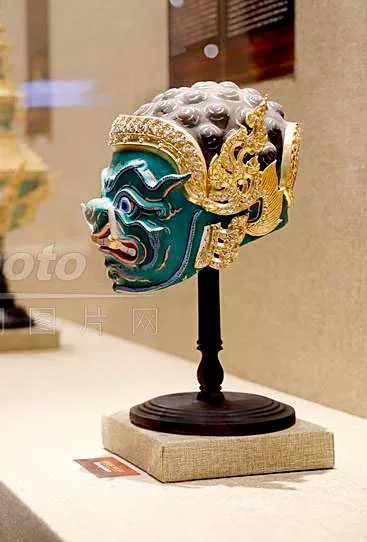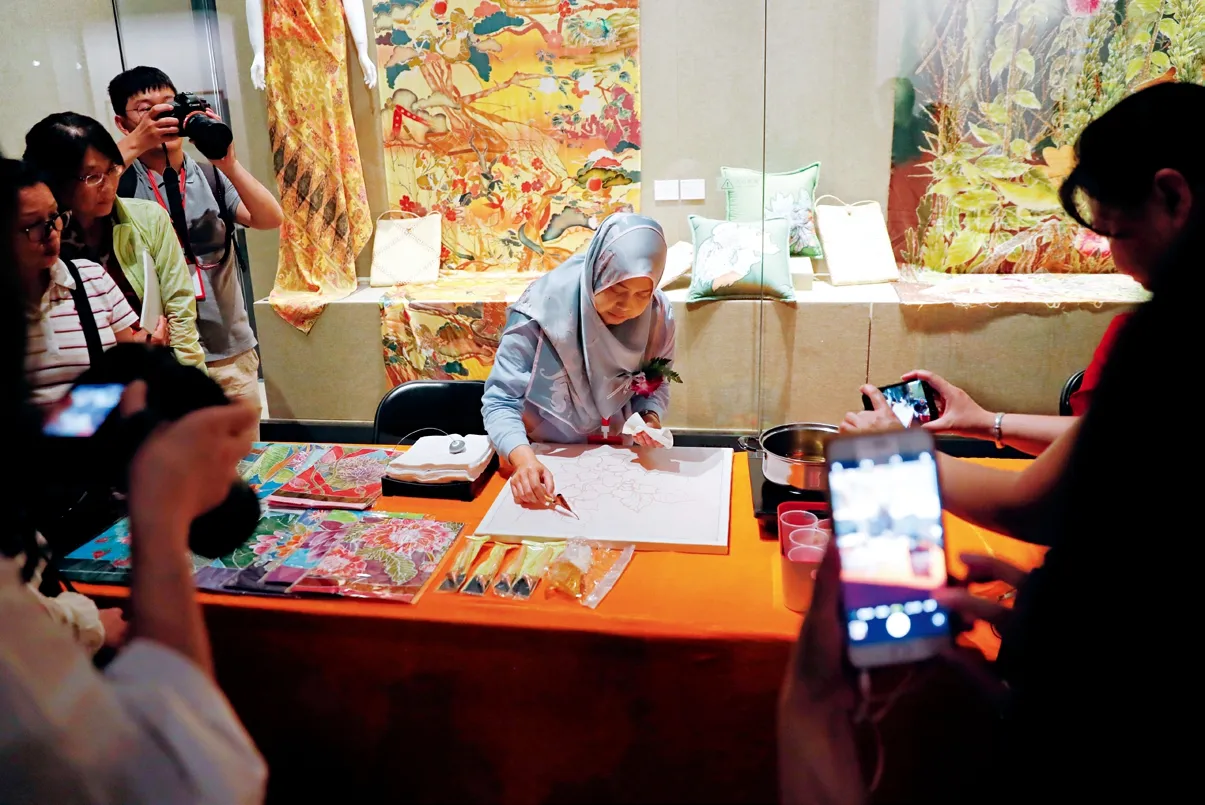EXHIBITING ASIA
By Wang Fang
The beauty of Asian civilizations shines at exhibitions accompanying the Conference on Dialogue of Asian Civilizations
The works profoundly display the uniqueness of Asian civilizations and the coexisting cultural origins among Asian countries.
A ncient Chinese civilization, Indian civilization and Babylon civilization, all born on the Asian continent, represent important chapters of human history. Asia has plentiful splendors of world civilization. In May, several exhibitions themed on Asian civilizations kicked off in Beijing during the Conference on Dialogue of Asian Civilizations, offering a feast of Asian arts and civilizations.
Varied Genres
The National Art Museum of China hosted“Shared Inspiration—Asian Art Exhibition,” which showcased 130 pieces by artists from 41 countries including China, the Philippines, Laos, Malaysia,Myanmar, Thailand, Singapore, Indonesia, Vietnam and others.Works of different genres including Chinese ink and wash paintings, oil paintings, prints and sculptures were all on display, preserving the beautiful landscapes and cultural spirit of China and other Asian countries through artistic creation.The works profoundly display the uniqueness of Asian civilizations and the coexisting cultural origins among Asian countries.

“Shared Inspiration—Asian Art Exhibition”kicked off at the National Art Museum of China on May 12.
A bronze statue stood in the exhibition hall.Titled Asking the Way—Dialogue between Confucius and Laozi, it was created by Wu Weishan, curator of the National Art Museum of China. “This work aims to bring life to the traditional Chinese philosophy of the Way,” revealed Wu. “It is an invitation sent out to the world indicating that we want to discuss the Way with the rest of the world and that we want to learn from others.”
The traditional Chinese painting Peace for Ten Thousand Years by Chinese painter Qi Baishi,located in the Freehand Brush Work section,attracted many visitors. Completed in 1952, it is a traditional Chinese ink painting featuring a blooming lotus flower in summer surrounded by dark green leaves made of simple brush strokes. The work demonstrates the typical beauty of traditional Chinese painting. “Lotus flower” sounds the same as “peace” in Chinese, so the image also connotes hope for lasting peace. Other paintings featuring the lotus also made the exhibition, including Wu Guanzhong’s oil painting Red Lotus and Zhong Shuyan’s oil painting Lotus. Together, these flowery pieces highlight organizers’ appreciation of cultural diversity, peace and harmony in Asia.
Alongside works by Chinese artists, many paintings and sculptures by other Asian artists were also shown and attracted great attention.Wu introduced to us Ceremony on Red Earth by a Philippine painter. “This painting navigates the relationship between man, nature and animals,shining light on the willingness of humans to coexist in harmony with nature.”Diverse artistic styles were seen in the exhibition,each artist portraying the beauty of a different subject or place with unique eyes and soul. Four Malaysian Girls by Chinese painter Situ Qiao vividly depicts Malaysian local culture and customs. The Color of Old Age - Angkor Wat by Lu Yushun reflects the vicissitudes of history with mottled lines, and Charm of Vietnam by Ya Ming shows the tender beauty of Vietnam with inked brush lines.
Wu Weishan shared his own understanding of the dialogue of civilizations. In his view,the core of art is beauty. Dialogue between individuals, among nations, and among different ethnicities enables their contrasting beauties to mingle and exist in harmony with each other. “The exhibits emit the temperature and characteristics of the countries they hail from,” Wu commented. “Their communications and interactions will inspire greater exchanges and communications in the future. This mode of exchanges among Asian countries could be an ideal model for exchange between Asia and other continents.”
“This is a rare opportunity to see so many cultural treasures all at the same place.”

A mask used in the traditional Thai dance Khon on display at the“Craftsmanship of Civilizations”exhibition, which kicked off at the National Museum of Classic Books on May 16.
Bridging the Past and Present
“The Splendor of Asia—An Exhibition of Asian Civilizations” is still showing at the National Museum of China with exhibits including statues from Angkor Wat, a copper drum from pre-historic Laos, a harp unearthed from Myanmar and many others, cataloguing the diverse and profound cultures of Asia.
The video program Splendor of Asia runs continuously on a big screen, displaying rich cultural relics and scenes of famous civilizations of Asia and the world. Pieces of some relics can be seen at the exhibition to help demonstrate the historical and cultural characteristics of different civilizations.
“This is a rare opportunity to see so many cultural treasures all at the same place,” gasped Mr. Zhang from Singapore. Having previously researched cultural relics, Zhang was able to date a small porcelain bowl with intricate designs as produced during Emperor Guangxu’s reign (1875-1908) of the Qing Dynasty. The painted patterns of peony and phoenix on the porcelain are typical Chinese, but the added Malaysian cultural elements result in a perfect fusion of the cultural and economic exchanges happening along the Maritime Silk Road during that period.
According to Chen Mingwei, curator of the Asian Civilization Museum of Singapore, of the 18 objects from Singapore on display, half are porcelains by local Chinese descendants, who integrated Chinese ways with the local culture. The exhibited porcelain products made in the Qing Dynasty preserve Chinese artistic style but were used according to Malay living customs.
The exhibition has attracted endless streams of enthusiastic visitors. Art enthusiast Xu Rong took a whole day off work to see this exhibition. “This is my third visit to this exhibition,” she revealed.“I was really excited for the opportunity to have so many rare cultural treasures right before my eyes.”
A stone Buddha’s head statue in the Cambodia section has been particularly popular. It is a relic of the pre-Angkor period in the 7th Century preserved in the Cambodian National Museum. “We are proud that we are able to present our splendid ancient civilization alongside so many other Asian civilizations—it shows the unity among us,” said vice minister of culture and art of the Kingdom of Cambodia. “China and Cambodia recently increased their exchange and communication across more fields, especially the cultural sphere, and Cambodiahas started to play an increasingly important role in the Belt and Road Initiative.”

“The Splendor of Asia—An Exhibition of Asian Civilizations” opened at the National Museum of China on May 13.

A Malaysian artist displays batik skill at “Craftsmanship of Civilizations”exhibition, which kicked offat the National Museum of Classic Books on May 16.
The exhibition includes over 400 cultural relics from 47 Asian countries as well as some from Greece and Egypt, two other important ancient civilizations. “Asia is the birthplace of many old civilizations,” commented Guang Qiang, head of the Chinese National Cultural Heritage Administration.“I hope this exhibition will shine light on the long history and splendid, rich and diverse cultures of Asia for the rest of the world to see, and to bridge the past with the present.”
Communication Platform
Many artistic living utensils remain part of daily life after inheriting rich cultural traditions of old civilizations. The exhibition “Craftsmanship of Civilizations” held at Beijing’s National Museum of Classic Books in May showed 320 pieces of intangible cultural heritage from 14 Asian countries including fabrics and shell ornaments from the Philippines, weaving rattans from Malaysia, opera masks and porcelain sets from Thailand, lacquer items from Vietnam, shadow puppets from Indonesia, wood carvings and silk embroidery from China, among many others.
At the center of the exhibition hall is an Asian living room to highlight the Chinese concept of study room and tea house. Most eye-catching is the blackwood furniture with delicate designs and intricate wood carvings. It was made with Chinese mortise and tenon joints, and the engravings tell the story of ancient Chinese sage Confucius touring the country to teach his doctrine. The furniture was designed by Wang Tianxiang, an inheritor of Chinese intangible cultural heritage woodcarving,and built by six carpenters and wood carvers over three years. “I am honored for the opportunity and learned a lot by participating in this exhibition of intangible cultural heritage works,” declared Wang Tianxiang. “It has been a good opportunity to present the glamor of traditional Chinese culture,but we have also found considerable inspiration through exchanges and communications with artists from other Asian countries.”
Some live shows were performed during the exhibition such as a Malaysian batik designer showing how to dye and produce wall cloth and scarves. Khon Opera is a symbol of traditional Thai culture integrating painting, music,dancing and martial arts performance. Colorful Khon Opera masks were a big attraction in the hall. In the Philippine section were clothes and pearl necklaces used by Igorots of the northern Philippines. The works in the exhibition highlighted different cultures and folk customs of different countries, providing an opportunity for visitors to absorb the beauty and charm of different civilizations.
“We are committed to spreading and passing on the rich craftsmanship of Asia and its colorful and splendid culture,” asserted an Indian artist.“Let us maintain, protect and promote world civilizations.”
“The exhibition built a communication platform for intangible cultural heritage inheritors,” beamed Fan Di’an, president of Chinese Academy of Fine Arts. “The exhibited intangible cultural heritage works reflect daily life, bring cultural heritage closer to us and make us feel how intangible cultural heritage helps facilitate happier living.”

